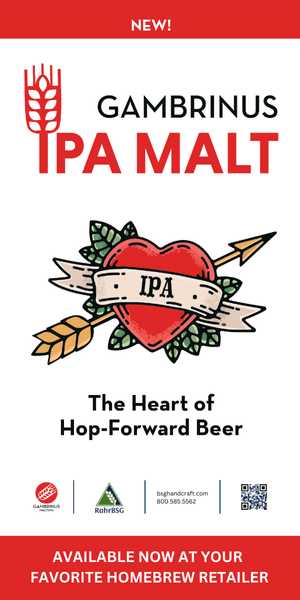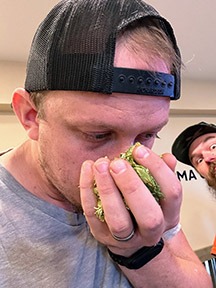Evaluating Hop Oil Content
There are no “Cascade” or “Saaz” aroma molecules, rather the relative proportions of hop oils drive their aroma contributions. The same four oils constitute 60-90% of the essential oils in every hop variety. Hop oils constitute less than 4% of a hop cone’s weight yet they provide most of the hop aroma, that combination of citrus, green, spice, and herb. Hop oil analysis provides an understanding of how to substitute and creatively pair hop varieties rather than simply referencing recipes or charts. With so many hop varieties released each year, evaluating oil content will enable you to cut through marketing hype and dial in hop combinations that fit your preferences.
To judge the contribution of a particular oil, add a large charge at flame-out and dry-hopping using a blend of at least three hop varieties high in your target oil. Blending hops in this way dilutes variety-specific aromatics. Alternatively, you can buy a beer brewed with several hops rich in the particular oil. For example Odell Brewing Co.’s (Fort Collins, Colorado) Myrcenary, as the name implies, is brewed with hops high in myrcene (including Cascade and Chinook). London’s Fuller’s Brewery Extra Special Bitter is finished with Northdown, East Kent Goldings, and Challenger, making it a good choice for humulene. Many Czech-style Pilsners are rich in farnesene thanks to Saaz or Sterling. Caryophyllene is a bit trickier, but Moonlight Brewing’s (Fulton, California) delicious Reality Czeck is hopped exclusively with American Perle. You can also take this lesson in the opposite direction though, blending too many hop varieties together without thought often produces generically “hoppy” beers because the oils average out.
Myrcene volatilizes particularly easily, much of it will be destroyed even with late-boil additions. If you want to retain more into the finished beer, partially cool the wort (180–190 °F, 82–88 °C) before adding the flameout addition, and then allow the hops to steep for 30 minutes before continuing the chill. Dry hopping is an even more efficient option. Processing and storage of the hops also plays a crucial role; pelletizing destroys much of the myrcene, but also makes it easier for what remains to transfer into the wort. 1
Shifting Concentrations
While we can talk generally about which hops are high in a particular oil, the average amount for each oil can shift by as much as 10% from one year to the next. Farm-to-farm differences can be even more dramatic. Professional brewers receive an oil analysis, which is often combined with a trip to the growing region to evaluate lots of hops for selection. As homebrewers we are at the mercy of the market. Producers usually blend several lots of pelletized hops to reduce variation (whole hops generally aren’t blended). 2 Get in the habit of smelling every package of hops you open. Learn how each variety should smell and be willing to return or toss hops that smell old or off.
Commercial Hop Blends
In addition to blending pellets from different lots of the same variety, Hopunion mixes multiple varieties to create proprietary blends. The most popular blend, Falconer’s Flight®, was first released in 2010, with a portion of the profits going to the Glen Hay Falconer Foundation. Described as “Distinct tropical, floral, lemon, and grapefruit characteristics,” the goal is to allow brewers to use a combination of sought-after varieties without needing to buy and store each in quantity. Hopunion also produces 7C’s® (a blend of seven “C” hops) and Zythos®.
Jesse Umbarger, who selects the lots that go into the blends every year, relies on sensory analysis rather than the oil content of the available hops. He explained, “I am looking for the bales of hops that possess the characteristics that the hop should possess traditionally, bright, dank (sometimes a positive), etc.” The goal of all three blends is to maintain consistent character from harvest-to-harvest, in a way that is impossible for a single variety, especially as a homebrewer. Jesse explains, “With a hop blend such as Falconer’s Flight®, if one of the nine varieties has a major shift in aroma or typical characteristics the overall influence or change to the blend is reduced by one-ninth.” Using nine hops (including two experimental varieties), allows Hopunion to provide a reliable supply at a reasonable price.
While I have tasted some delicious beers hopped exclusively with blends (e.g., DC Brau’s On the Wings of Armageddon is all Falconer’s Flight®), I prefer having control over exactly what varieties I’m adding to my beer. I’m not as worried about sensory changes compared to a commercial brewery, and I’d rather rely on my own sensory analysis (even if that sometimes means throwing away hops).
Designing Your Own Blend
One of my favorite brewers of hoppy beers is Alpine Beer Co. (Alpine, California) whose beers (especially Duet, Nelson, and my favorite, Hoppy Birthday) always have just the right hoppy balance of green, citrusy, and fruity characteristics. A few years ago Owner and Brewmaster Pat McIlhenney hinted at one recipe design secret: Pat targets a hop oil ratio across beers. To determine his ideal target he started by brewing single hop beers, which “proved invaluable. Understanding the individual sensory characteristics helped when analyzing the hop oil profiles,” he said. Pat wouldn’t reveal his specific ratio, but considering Duet is equal parts Simcoe® and Amarillo® and Nelson is a blend of Nelson Sauvin and Southern Cross, both would have high amounts of both humulene and myrcene. As Pat suggested, “All of the hop oils are important, some in abundance some in absence.” While this approach lays down a hoppy base across recipes, trace oils resident in the various hops provide unique character to each beer. Analyzing oil profiles is a great way to select an initial blend, but there is no substitute for brewing a batch and dialing in the recipe based on your sensory preferences.
To estimate the percentage of each oil in your beer, calculate the relative weights of the hops, total oil content in each, breakdown of that oil, and timing of the additions. It is possible to compute these figures by hand, but I devised a spreadsheet to simplify the process. Luckily, my friend Scott Janish took what I had done about five steps further with the help of Hopunion to create a slick web-based hop oil calculator: http://scottjanish.com/hop-oils-calulator/. Input your hop bill and Scott’s program will output a graph of hop oils and projected flavor/aroma descriptors based on average hop analysis.
Try analyzing a few favorite IPA recipes you’ve already brewed (or commercial clone recipes); see any trends? Maybe you have a favorite oil profile and just don’t know it yet! Scott ran a correlation across 25 batches of his hoppy homebrew and discovered that, “Farnesene seems to always have a negative impact in how I rate a beer’s aroma, flavor, and overall excitement when added to the dry hop.”
While mathematical analysis of hop oil content is no replacement for sensory analysis, it can provide some assistance when substituting varieties, designing a hop bill, or evaluating a new variety. As homebrewers we need to take every advantage we can when dealing with hops, which is unfortunately the beer ingredient that is both the most variable, and the one we have the least control over!
References
1 https://beersensoryscience.wordpress.com/tag/myrcene/
2 http://www.scottjanish.com/hops-understanding-blends-oil-testing
Brewer’s cut (sample) from a bale of Cascade hop cones.
Hop Oils
Big Four
Myrcene: Green, resinous. Hops: Amarillo®, Citra®, Motueka, Cascade
Humulene: Piney, woody. Hops: Hallertau, East Kent Goldings, Nelson Sauvin, Northdown
Farnesene: Floral Hops: Sterling, Saaz, Santium, Tettnang
Caryophyllene: Woody Hops: Vanguard, Perle, East Kent Goldings, Admiral
Others
B-Pinene: Woody-green, pine Hops: Centennial, Bravo, Ahtanum
Linalool: Floral, orange Hops: Ultra, Horizon, Liberty
Geraniol: Floral, sweet, rose Hops: Brewer’s Gold, Centennial, Cluster
Source: Stan Hieronymus For the Love of Hops




